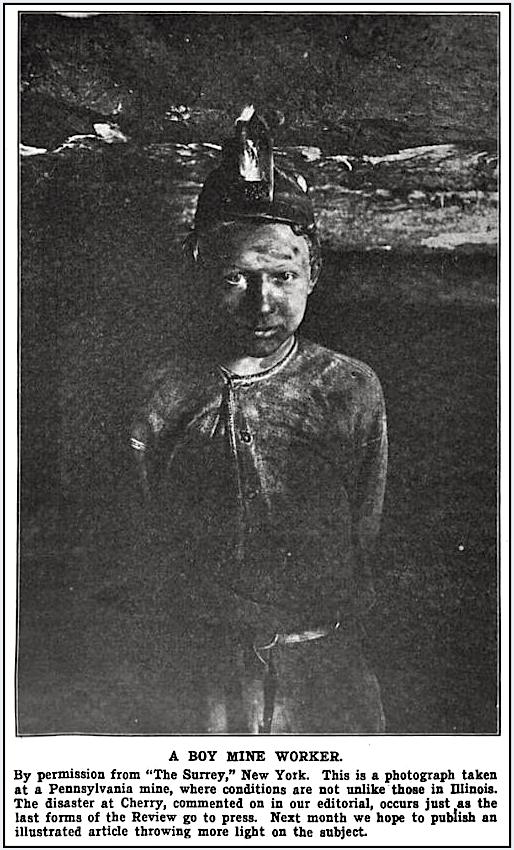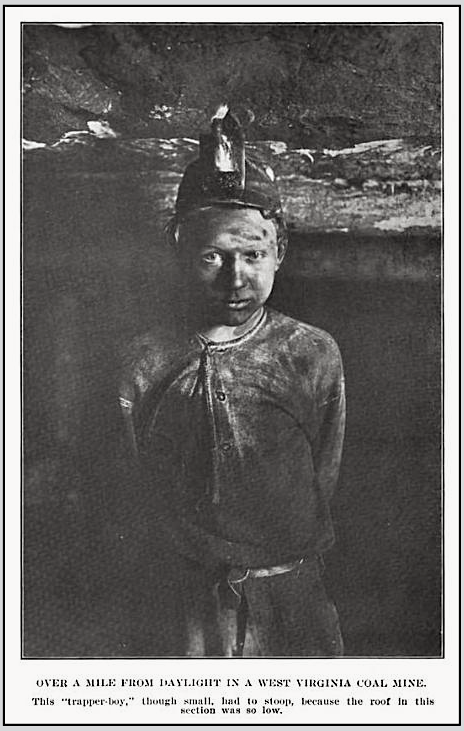 ———-
———-
Hellraisers Journal – Friday December 10, 1909
“A Boy Mine Worker,” Like Those Who Perished in the Cherry Mine-Fire
From the International Socialist Review of December 1909:
“A Boy Mine Worker”
Note: Photograph is by Lewis Hine of Trapper Boy in a West Virginia Coal Mine, see Survey of October 2, 1909.
From the Editor’s Chair
The Murder of Illinois Miners
On Saturday, Nov. 13, fire broke out in the mine of the St. Paul Coal Company at Cherry, Ill., where 708 miners were at work. Next morning 125 men responded to roll call. A few more may have escaped, but the actual number dead in the mine is probably close to 500. The newspaper reports of the fire were so conflicting, and so obviously toned down in the interests of the mine owners, that the Review sent its own representative to Cherry, in order that we might make an accurate statement of the facts before commenting on them. He found the reporters of the capitalist papers snugly housed in Pullman cars, wined and dined by St. Paul officials. He found the surviving miners unanimous in the opinion that the death of their comrades was directly due to the action of the mine officials in keeping the men at work long after the fire started. Direct evidence that this is the case is not wanting. Our representative asked President Earling of the St. Paul Railway at what hour the fire started. He replied, “One thirty.” To the question, “Why weren’t the men notified?” his only answer was an eloquent gesture indicating that he had nothing to say.
Arturo Pastelli, a young Italian employed in the mine, stated positively to our reporter that at 1:40 P. M. he noticed the fire and hurried to the “cage” at the foot of the main shaft. He urged the petty official in charge there to notify the miners of the fire, and was told to go back to work and mind his own business. He insisted on being hoisted up to the surface, and went directly to the manager, told him of the fire and urged that the men be brought up. His answer was: “We know all about it; you go home and mind your own business.” Instead of going home he remained in sight, and saw coal being hoisted for an hour and ten minutes, while the fire was gradually spreading below.
Ben Ferguson says that he left the “diggings” at 2:40 P. M., without having at any time been notified of the fire, and that he was on the last cage that brought men up. Domino Maratto, the list man taken out, says it was ten minutes to three when he reached the top of the shaft. We mention these names because the testimony of these particular men is direct and at first hand. But they simply confirm what is a matter of common knowledge, that practically every life lost could have been saved by prompt action of the officials in charge of the mine.
The cause for their inaction is not far to seek. Knowing the wishes of the magnates who own the mine, they feared the loss of their own jobs if the process of profit-making were to be suspended one hour before the regular closing time, and so preferred to risk hundreds of lives that they might keep the favor of those above them. This view is confirmed by other well known facts. Our reporter measured the distance between the main shaft and the air shaft of the mine. It is 210 feet. The Illinois law requires that the distance be at least 300 feet. The mine was supposed to be lighted by electricity, but the lighting plant had been out of commission for six weeks, while profit-making went merrily on, and the fire was directly due to the contact of an unprotected torch with a bundle of hay.
And the Chicago Tribune on the day after the disaster said that the mine at Cherry was considered the best equipped coal mine in Illinois. If this was the best, what must the others be?
What will come of it all? Reformers and philanthropists are already discussing changes in the laws to make mining safer for the miners. But we have just seen that the present laws on the subject are not enforced, and it requires the childlike faith of a sentimentalist to put faith in new laws, with the capitalists still owning both the mines and the government. The State is the state of the capitalists. Nothing but revolution will make it the state of the wage-workers. Not until the mines are controlled by those who work in the mines will the lives of the miners be safe. Not until the tools of all industries are controlled by the workers in those industries will the demand of the laborers for better working conditions be effective.
The surviving miners at Cherry, Illinois, are not discussing reforms. Reforms do not interest the wives, daughters and sweethearts of the men who went down into that mine never to return. These men and women are filled with a desperate rage against the capitalist murderers—a rage that would wipe them off the earth if opportunity came. Kept in submission by the soldiers of the capitalist government, they will smother their rage for the time, but the spirit of revolt will live and grow.
The burning of these Illinois miners is one among the daily incidents of capitalist production. Because hundreds on this occasion are sacrificed at one time and one place, the world stops for a moment to look and listen and shudder. But wherever the work of the world is done, men, women and children are being crushed to death or crippled for life in the daily struggle for bread on the part of the workers and for profits on the part of the capitalists. And day by day, with each new tragedy in the lives of some new group of workers, the inner fires of revolt burn fiercer and fiercer, waiting their time to burst forth.
It is for the growing army of clear-headed revolutionists to find the way in which this gigantic energy may so direct itself as to over throw capitalism once for all. Drunk with power, the capitalists are helping on the work of revolution by stamping out the old craft unions with their “community of interest between employer and employed.” Thus the way is being cleared for a revolutionary union, backed by a revolutionary party, to unite the strength of the workers, to grasp with strong hands the tools now used to enslave those who wield them, and to break the world’s last chains.
———-
[Emphasis added.]
~~~~~~~~~~~~~~~~~~~~~~
SOURCES & IMAGE
Mother Jones Quote, Child Labor Man of Six Snuff Sniffer
https://www.iww.org/history/library/MotherJones/autobiography/14
The International Socialist Review, Volume 10
(Chicago, Illinois)
C. H. Kerr & Company,
July 1909 – June 1910
https://books.google.com/books?id=MVhIAAAAYAAJ
-ISR of Dec 1909
https://play.google.com/books/reader?id=MVhIAAAAYAAJ&printsec=frontcover&pg=GBS.PA483
PN (WV) Boy Mine Worker
https://play.google.com/books/reader?id=MVhIAAAAYAAJ&printsec=frontcover&pg=GBS.PA512
Editor’s Chair -“Murder of Illinois Miners”
https://play.google.com/books/reader?id=MVhIAAAAYAAJ&printsec=frontcover&pg=GBS.PA550
See also:
Tag: Great Cherry Mine Disaster of 1909
https://weneverforget.org/tag/great-cherry-mine-disaster-of-1909/
The Survey, Vol. 23
(New York, New York)
-Oct 1909 – Mar 1910
Charity Organization Society, 1910
https://books.google.com/books?id=qFDMlinpHZ8C
-Oct 2, 1909: Southerners of Tomorrow
Photographs by Lewis W. Hine for the
National Child Labor Committee
https://play.google.com/books/reader?id=qFDMlinpHZ8C&printsec=frontcover&pg=GBS.PR15
“Trapper Boy” was taken in WV, not PA
https://play.google.com/books/reader?id=qFDMlinpHZ8C&printsec=frontcover&pg=GBS.PA2
~~~~~~~~~~~~~~~~~~~~~~~~~~~~~~~~~~~~~~~~~~~~~
Breaker Boys
We Will Sing One Song


